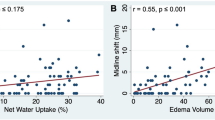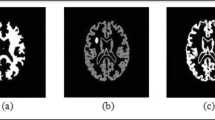Abstract
Purpose
Diffusion-weighted imaging (DWI) is a widely used medical imaging modality for diagnosis and monitoring of cerebral stroke. The identification of exact location of stroke lesion helps in perceiving its characteristics, an essential part of diagnosis and treatment planning. This task is challenging due to the typical shape of the stroke lesion. This paper proposes an efficient method for computer-aided delineation of stroke lesions from DWI images.
Method
Proposed methodology comprises of three steps. At the initial step, image contrast has been improved by applying fuzzy intensifier leading to the better visual quality of the stroke lesion. In the following step, a two-class (stroke lesion area vs. non-stroke lesion area) segmentation technique based on Gaussian mixture model has been designed for the localization of stroke lesion. To eliminate the artifacts which would appear during segmentation process, a binary morphological post-processing through area operator has been defined for exact delineation of the lesion area.
Result
The performance of the proposed methodology has been compared with the manually delineated images (ground truth) obtained from different experts, individually. Quantitative evaluation with respect to various performance measures (such as dice coefficient, Jaccard score, and correlation coefficient) shows the efficient performance of the proposed technique.











Similar content being viewed by others
References
Taylor FC, Suresh Kumar K (2012) Stroke in India fact sheet (updated 2012). South Asia Netw, Chronic Dis, Hyderabad
Bryan RN, Levy LM, Whitlow WD, Killian JM, Preziosi TJ, Rosario JA (1991) Diagnosis of acute cerebral infarction: comparison of CT and MR imaging. Am J Neuroradiol 12:611–620
Maier S, Gudbjartsson H, Patz S, Hsu L, Lovbald KO, Edelman RR, Warach S, Jolesz FA (1998) Line scan diffusion imaging: characterization in healthy subjects and stroke patients. AJR Am J Roentgenol 171:85–93
Kidwell CS, Alger JR, Di Salle F, Starkman S, Villablance P, Bentson J, Saver JL (1999) Diffusion MRI in patients with transient ischemic attacks. Stroke 30:1174–1180
Agam G, Weiss D, Soman M, Arfanakis K (2006) Probabilistic brain lesion segmentation in DT-MRI. In: Image Process. 2006 IEEE Int. Conf. IEEE, pp 89–92
Prakash KNB, Gupta V, Bilello M, Beauchamp NJ, Nowinski WL (2006) Identification, segmentation, and image property study of acute infarcts in diffusion-weighted images by using a probabilistic neural network and adaptive gaussian mixture model. Acad Radiol 13:1474–1484
Kabir Y, Dojat M, Scherrer B, Forbes F, Garbay C (2007) Multimodal MRI segmentation of ischemic stroke lesions. In: Eng. Med. Biol. Soc. 2007. EMBS 2007. 29th Annu. Int. Conf. IEEE. IEEE, pp 1595–1598
Hevia-Montiel N, Jimenez-Alaniz JR, Medina-Banuelos V, Yanez-Suarez O, Rosso C, Samson C, Baillet S (2007) Robust nonparametric segmentation of infarct lesion from diffusion-weighted MR images. In: Eng. Med. Biol. Soc. 2007. EMBS 2007. 29th Annu. Int. Conf. IEEE. IEEE, pp 2102–2105
Shen S, Szameitat AJ, Sterr A (2008) Detection of infarct lesions from single MRI modality using inconsistency between voxel intensity and spatial location–a 3-D automatic approach. Inf Technol Biomed IEEE Trans 12:532–540
Li M, Ai L, He H, Zheng Z, Bin LV, Li W, Yi J, Chen X (2009) Segmentation of infarct in acute ischemic stroke from MR apparent diffusion coefficient and trace-weighted images. In: Sixth Int. Symp. Multispectral Image Process. Pattern Recognit. International Society for Optics and Photonics, p 74971U–74971U
Forbes F, Doyle S, Garcia-Lorenzo D, Barillot C, Dojat M (2010) Adaptive weighted fusion of multiple MR sequences for brain lesion segmentation. In: 2010 IEEE Int. Symp. Biomed. Imaging From Nano to Macro. IEEE, pp 69–72
Wilke M, de Haan B, Juenger H, Karnath H-O (2011) Manual, semi-automated, and automated delineation of chronic brain lesions: a comparison of methods. Neuroimage 56:2038–2046
Mujumdar S, Varma R, Kishore LT (2012) A novel framework for segmentation of stroke lesions in diffusion weighted MRI using multiple B-value data. In: Pattern Recognit. (ICPR), 2012 21st Int. Conf. IEEE, pp 3762–3765
Mohd Saad N, Abdullah AR (2012) Automated region growing for segmentation of brain lesion in diffusion-weighted MRI. In: International multiconference of engineers and computer scientists, IMECS 2012, March 14–16, Hong Kong
Maier O, Wilms M, von der Gablentz J, Kramer UM, Munte TF, Handels H (2015) Extra Tree forests for sub-acute ischemic stroke lesion segmentation in MR sequences. J Neurosci Methods 240:89–100
Chyzhyk D, Dacosta-Aguayo R, Mataró M, Graña M (2015) An active learning approach for stroke lesion segmentation on multimodal MRI data. Neurocomputing 150:26–36
Havaei M, Guizard N, Larochelle H, Jodoin P-M (2016) Deep learning trends for focal brain pathology segmentation in MRI. arXiv Prepr. arXiv:1607.05258
Chaira T, Ray AK (2009) Fuzzy image processing and applications with MATLAB. CRC Press, Taylor & Francis Group, Boca Raton
Biernacki C, Celeux G, Govaert G (2000) Assessing a mixture model for clustering with the integrated completed likelihood. Pattern Anal Mach Intell IEEE Trans 22:719–725
Zou KH, Warfield SK, Bharatha A, Clare MCT, Kaus MR, Haker SJ, Wells WM, Jolesz FA, Kinkis R (2004) Statistical validation of image segmentation quality based on a spatial overlap index 1: scientific reports. Acad Radiol 11:178–189
Acknowledgements
The authors would like to acknowledge EKO CT and MRI Scan Centre, Medical College and Hospitals Campus, Kolkata, and Apollo Multispecialty Hospital for providing image data for this study.Funding This work was funded by Board of Research in Nuclear Sciences (BRNS), Dept. of Atomic Energy, Govt. of India (Grant number: 2013/36/38 dated: 25/11/2013).
Author information
Authors and Affiliations
Corresponding author
Ethics declarations
Conflict of interest
The authors declare that they have no conflict of interest.
Ethical approval
All procedures performed in studies involving human participants were in accordance with the ethical standards of the institutional and/or national research committee and with the 1964 Helsinki declaration and its later amendments or comparable ethical standards.
Informed consent
Informed consent was obtained from all participants included in the study.
Rights and permissions
About this article
Cite this article
Nag, M.K., Koley, S., China, D. et al. Computer-assisted delineation of cerebral infarct from diffusion-weighted MRI using Gaussian mixture model. Int J CARS 12, 539–552 (2017). https://doi.org/10.1007/s11548-017-1520-x
Received:
Accepted:
Published:
Issue Date:
DOI: https://doi.org/10.1007/s11548-017-1520-x




